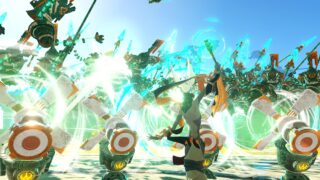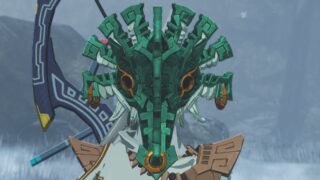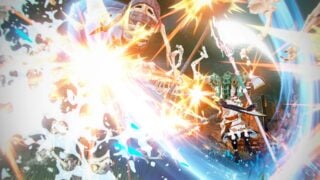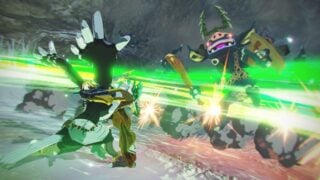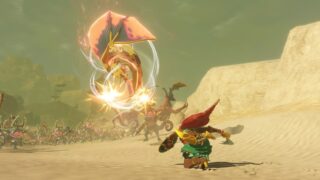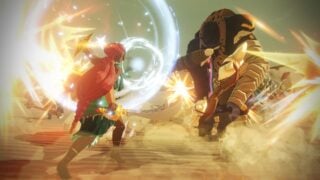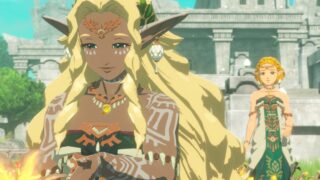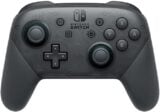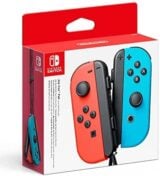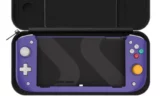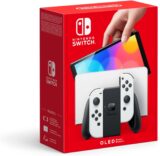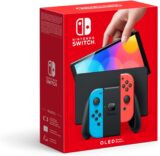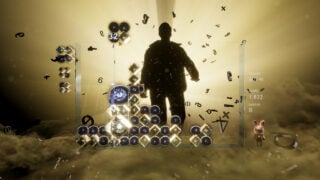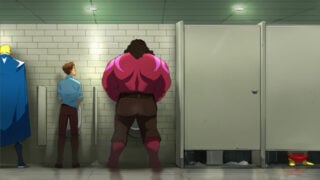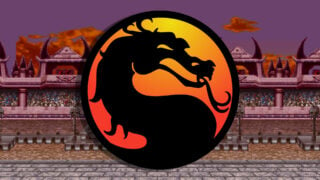Hyrule Warriors Age of Imprisonment review: This time it’s canon(dorf)
The most serious Hyrule Warriors to date is also the one with the most engaging and rewarding combat
- Director
- Koki Aoyanagi
- Key Credits
- Yosuke Hayashi (Producer), Ryota Matsushita (Producer)

By this point, the Zelda timeline is such a convoluted tangle of alternate realities that if you were to draw it out, you’d end up with a London Underground map.
That’s why the Hyrule Warriors games can offer a welcome slice of relief. Both the original Hyrule Warriors on Wii U and its Switch sequel Hyrule Warriors: Age of Calamity are considered non-canon, with both messing around with time travel to create fun ‘what if’ scenarios where players can relax without having to worry about whether it fits into the Fallen Hero Timeline, or how it takes place in relation to The Minish Cap.
While the third entry, Nintendo Switch 2‘s Hyrule Warriors: Age of Imprisonment, also deals with time travel, this time Nintendo and Koei Tecmo have decided it’s canon, mainly because the time travel in question this time is the legit kind which actually happened in the story – specifically, the bit in Tears of the Kingdom where Zelda encounters Ganon, activates her Secret Stone and accidentally travels back in time to the creation of Hyrule.
It’s here where she meets Rauru and Sonia, the first King and Queen of Hyrule, and witnesses first-hand the Imprisoning War, where Ganondorf attempts his first attack and takeover of Hyrule Castle. Of course, if you’ve already played through Tears of the Kingdom and unlocked the 18 memory cutscenes by finding the Dragon’s Tear items on the map, you’ll already know all this.
Get ready to know it all over again, then, because Hyrule Warriors: Age of Imprisonment is essentially a ‘Director’s Cut’ of sorts of this plot, shedding more light on Zelda’s time spent in the past, the other characters she encounters there, and how everything (probably) fits together in the overall Legend of Zelda timeline.
Given that the story was previously already told in about 45 minutes’ worth of Tears of the Kingdom cut-scenes, Age of Imprisonment also adds some side-plots which weren’t seen in the 2023 game but do eventually contribute to the main conclusion. The most notable of these involves a new character called Calamo – he’s a young Korok who finds and befriends a character known only as the Mysterious Construct, a strange automaton who appears to be partly made of Zonai devices and can transform.
Calamo can initially be quite annoying – he’s very much the comic relief in Age of Imprisonment and if you played a drinking game where you took a shot every time he referred to the Mysterious Construct as his “bud” you’d be getting your stomach pumped before you even reach the halfway mark – but over time he does eventually become one of the most endearing characters in the game, and is all but guaranteed a fanbase, mark my words.
In terms of the actual gameplay itself, Age of Imprisonment is undoubtedly still a Warriors game – for the uninitiated, Koei Tecmo’s Dynasty Warriors series has had numerous licensed spin-offs for the likes of One Piece, Dragon Quest, Fire Emblem, Persona and these Zelda-themed Hyrule Warriors titles – but it also feels a bit like a game trying even more than its predecessors to appeal to those not interested in its hack-and-slash principles.
While the game’s missions are still undoubtedly full of swarms of enemies hundreds deep, they almost feel arbitrary here. While players can still wade into them with screen-filling combos, popping dozens of bad guys up into the air at a time, it’s also pretty easy – at least in the game’s default difficulty – to just run past them and head straight for the next big enemy you do actually have to beat to continue.
“Age of Imprisonment is undoubtedly still a Warriors game… but it also feels a bit like a game trying even more than its predecessors to appeal to those not interested in its hack-and-slash principles.”
When you do reach these larger enemies, there’s thankfully more depth to the combat than simply hammering the Y and X buttons to perform various combos until your Special meter is built up and you can unleash a powerful attack with the A button.
Each character has their own skills, which can be used when a larger enemy performs a powerful attack to counter them. These attacks are telegraphed with red energy, and could come as a dash, an aerial attack, a shield block, or a projectile attack. When the move starts, you have to hold R – which briefly freezes time – and decide which of your unique skills is the right one to counter their attack, stunning them.
You can also collect and use Zonai devices while battling. Some of these have similar effects to the unique skills, meaning if your character doesn’t have a skill that, for example, can deal with shields, you can use a bomb instead. Zonai devices use up a battery meter, so you have to top that up while fighting.

On top of all that, the Mysterious Construct (and certain other characters) can also use Fuse Attacks, where you can temporarily fuse collected materials to his weapon for a wider variety of attacks. Add to this the Sync Strikes – where each combination of characters has their own unique tag-team special move if they both build up a sync meter – and there’s a lot of variety here.
It’s especially pleasing during larger battles when you’re swapping between four characters, making use of all their different skills and teaming them up when needed. This also goes some way to making up for the fact that, to be frank, this has the least exciting roster of the three Hyrule Warriors games.
In a way, that’s understandable – because Age of Imprisonment is actually canon and set during the foundation of Hyrule, Koei Tecmo can’t just chuck Tingle in there for a laugh. The main roster consists of King Rauru and his six sages – Zelda, Rauru’s sister Mineru, Rito elder Raphica, Goron leader Agraston, Zora queen Qia and Gerudo warrior Ardi – as well as the aforementioned Mysterious Construct and his Korok ‘bud’ Calamo.
“When you do reach these larger enemies, there’s thankfully more depth to the combat than simply hammering the Y and X buttons to perform various combos until your Special meter is built up”
As it’s set during a time when there aren’t many other unique characters around, however, the typically large Warriors roster throughout the main story is padded out with multiple Rito, Zora, Goron, Gerudo, and Hylian fighters, almost all of whom are met here for the first time and forgotten almost as quickly.
Given the first game’s time-travelling silliness had players fighting as the likes of Midna from Twilight Princess, Young Link from Ocarina of Time, Fi from Skyward Sword, Skull Kid from Majora’s Mask and wonderfully strange inclusions like a Cucco (the Zelda universe’s chicken equivalent) and Link’s female alter-ego Linkle, to now have a rather conservative roster of multiple members of the usual Hyrule races is a bit underwhelming.
Link’s not even in here, though it’s clear that the Mysterious Construct, with its similar swordfighting ability, has been added in an attempt to make up for this. The Construct’s ability to transform also adds some variety to proceedings, most notably in the form of a few special flying stages, which transform the game into an on-rails shoot ‘em up all of a sudden.

It’s also worth noting that while there are some new subplots here that certainly expand the lore and teach players more about the earliest days of Hyrule, a lot of this story will be familiar to Zelda fans who have already played Tears of the Kingdom. A number of cutscenes – including arguably the most pivotal of the lot – are practically identical to some of the memory cutscenes from Tears of the Kingdom.
As long as you’re okay with a Hyrule Warriors game which is a little more restrained and takes its handling of the source material more seriously than its predecessors, there’s still a great time to be had here. The combat is the best in the Hyrule Warriors series to date, and once you’ve reached the credits, about 18-20 hours in, there’s still a hell of a lot to do thanks to a large map filled with side-quests, unlockable characters, and other missions.
The tweaks to its gameplay might still not be enough to completely convert players who just can’t get along with the Warriors ‘ hack-and-slash mentality, but players who click with the combat will find a wealth to do here, both during and after the main story.
Hyrule Warriors: Age of Imprisonment Review
Age of Imprisonment may be the most serious of the Hyrule Warriors games to date, but it's also the one with the most engaging and rewarding combat. Fans of Tears of the Kingdom may be annoyed to see an essential retelling of part of its story, but the side-plots add more depth to make up for this to some extent. Fans of the Warriors gameplay style will be absolutely catered for here.
- The most engaging combat in the Hyrule Warriors series to date
- Calamo and the Mysterious Construct are a fun duo
- Adds more depth to an already compelling plot
- Huge map with loads to do, even after the credits
- Smooth 60fps combat despite hundreds of enemies onscreen
- Roster isn't quite as fun or diverse as in previous Hyrule Warriors
- Some cutscenes are recycled from Tears of the Kingdom
